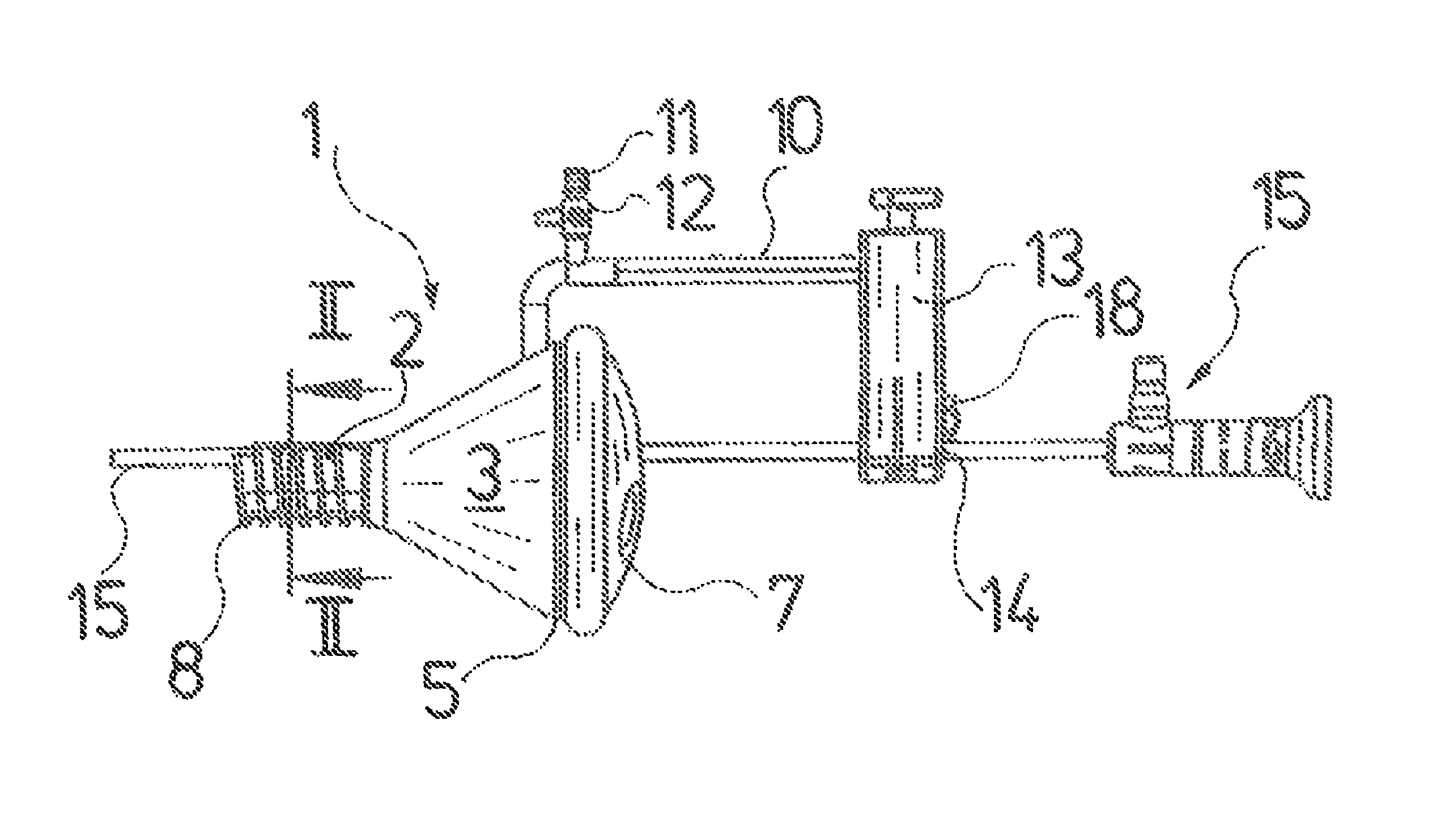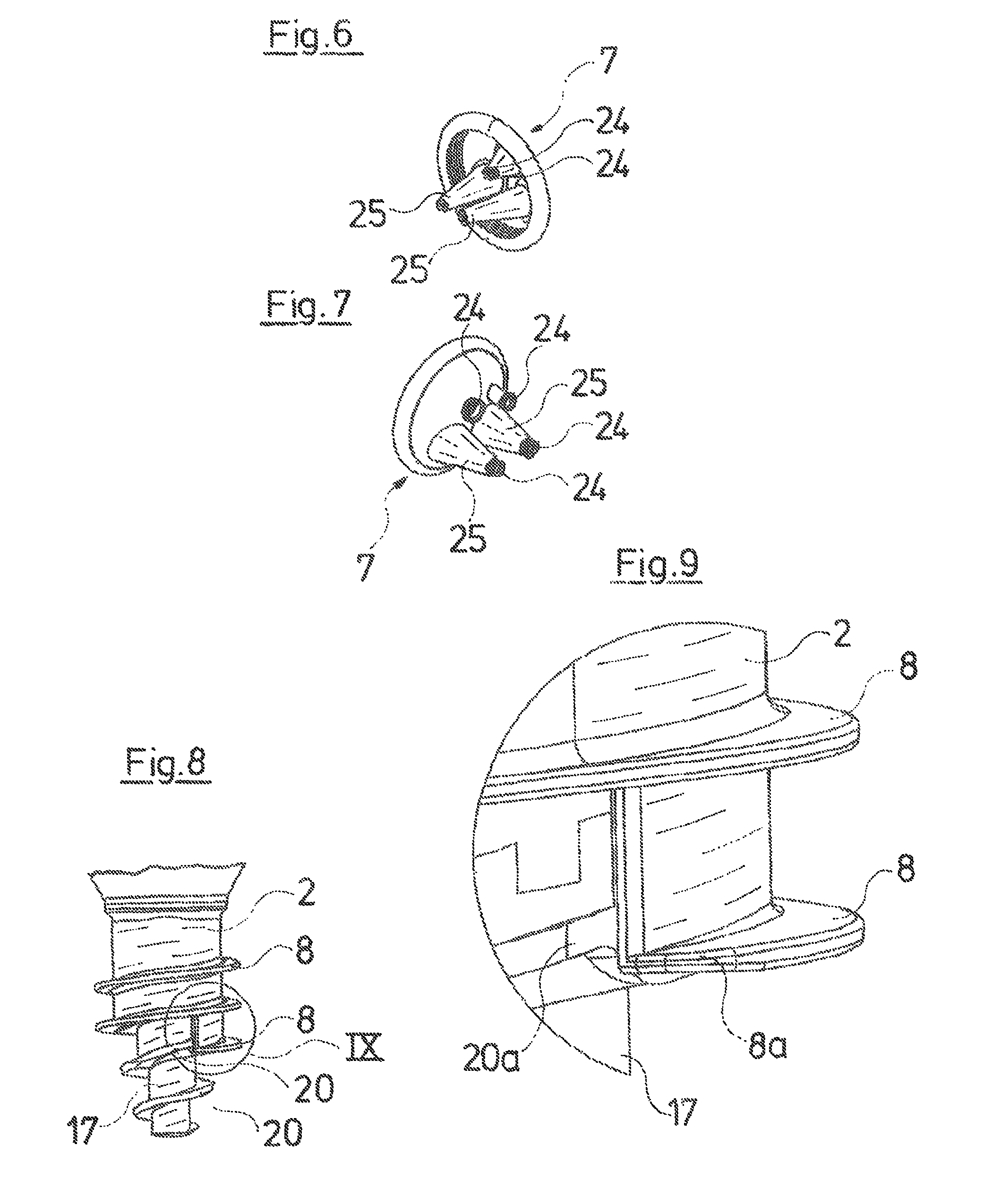[0005]Against this background, it is an object of the present invention to provide a trocar sleeve, which does not have the above-described disadvantages and, with a comparatively small cross section, ensures an improved access for instruments as well as an improved retention in the introduced body opening.
[0008]This design according to a preferred embodiment of the present invention is particularly advantageous, since, given the same cross-sectional area, a polygonal cross section is more favourable than a circular cross section with regard to the arrangement and the movement ability of the instruments to be led through. The pivoting ability of the instruments, thus their ability to be set obliquely with respect to the longitudinal axis of the trocar sleeve, is significantly improved and moreover the instruments mutually inhibit one another only to a limited extent. A further significant advantage is the support surface of the spiral which is larger compared to the state of the art, via which the body tissue, thus in particular the abdominal wall may be accommodated and thus the trocar sleeve fixed. Since differently effective widths of the spiral result due to the round outer contour and the polygonal tube cross section, the spiral sections lying parallel to the sides of the polygon may be designed wider than with a circular inner tube with comparable dimensions, by which means and improved compression of the abdominal wall and a more secure grip of the trocar sleeve within the abdominal wall may be achieved.
[0010]It has been found to be particularly advantageous to provide the distal tube section with a rounded, triangular cross section, thus in a manner such that flat tube walls which are typically but not necessarily arranged at an angle of 120° to one another, are formed, which by way of suitably rounded sections are connected into a tube, in a manner such that the wall thickness of the tube is constant over the periphery as well as over the length, and a continuous cross-sectional course results, as is typically useful for the creation of a gas-tight access, e.g., via the navel. Thereby, the rounded, triangular cross section of the tubular section on the one hand results in maximal degrees of freedom for the auxiliary instruments which are guided therethrough and, on the other hand, also results in maximal support surfaces of the spiral or spirals, specifically where these connect to the sides of the triangle cross section.
[0012]Advantageously, this may be realised in that, according to a further formation of the present invention, an end section is provided on the widened section of the trocar sleeve on the proximal side, said end section being provided with a peripheral bead, over which the sealing cap engages. The engagement of the sealing cap over the bead has several advantages with regard to application technology. On the one hand, such a seal is quick and simple to attach and remove by the user. Moreover, the sealing cap grips over the proximal edge of the trocar sleeve, by which means injuries in the region of this edge, as occasionally occur with funnel-like trocars of this type, may be avoided or at least reduced. The peripheral bead, which holds the sealing cap on the trocar sleeve, may be formed by grooving a groove or also by way of integrally forming onto the proximal-side end section. The groove arrangement moreover has the advantage that the sealing effect is not only achieved by way of the engagement over the bead, but by way of the bearing of the engaging-over cap edge in the groove, and moreover the sealing cap is held better.
[0015]It is particularly advantageous if the present inventive and previously described trocar sleeve is provided with a trocar, which as is known per se, may be fixed within the trocar sleeve and which comprises an end section which tapers distally into a tip. According to a further formation of the present invention, the outer contour of the trocar, in particular in the widest region of the tapered end section, is adapted to the outer contour of the inner cross section of the distal tube section of the trocar sleeve which in this region on an outer side is provided with at least one spiral. Thereby, this end section tapered into a tip also comprises a number of spirals which corresponds to that of the distal tube section, which are likewise arranged rising proximally from the tip in a helical manner, and the flush or proximally displaced spirals connect on the periphery of the distal tube section, when the trocar is fixed in the trocar sleeve in the correct position for creating an access through the abdominal wall. Thereby, analogously to the spiral arrangement and the cross-sectional shape in the region of the distal end section, it is particularly useful if the trocar, in the region of its end section which is tapered towards the tip, has a circular cross section, thus a conical shape, whereas the spiral or spirals in their width is or are formed corresponding to the inner contour of the surrounding distal tube section of the trocar sleeve. Then, in the region of the end section of the trocar which tapers into a tip, on the one hand a simple penetration into the body results, wherein a large support capability in this region is given on account of the at least sectional, comparatively wide spirals, and this support capability securely prevents the trocar from slipping away already after a small penetration. Moreover, the trocar with its end section tapering into a tip, in its correct introduction position, is advantageously arranged such that it does not completely penetrate the trocar sleeve, in particular in the region of the distal tube section, so that a positive fit between the proximal part of the this end section and the distal part of the distal tube section of the trocar sleeve is formed, so that a torque may be transmitted from the trocar sleeve onto the trocar, which is particularly advantageous for introduction.
 Login to View More
Login to View More  Login to View More
Login to View More 


